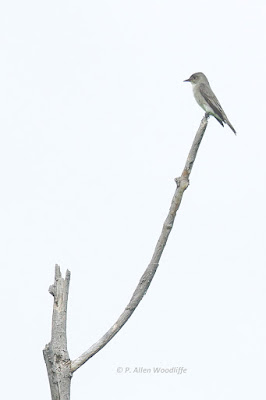A few days ago I stopped in at Erieau hoping that the Franklin's Gull that was reported a few days earlier, or a
Little Gull might be around with the others. While standing adjacent to the
channel and scanning the gulls with a scope along the far shore of Rondeau, a
'largish small' gull, larger than nearby Bonaparte's, flew into view. It had an
almost complete black hood, a largish dull red bill, upper wing solid gray
changing to solid black at the last quarter of the wing tip. The underside of
the wings were mostly white, slightly grayer at the trailing edge and the last
quarter of the wing tips were solid black. I never saw it land, it flew around
for about a minute and then headed west towards the fish tug harbour when I
lost it from view behind trees. It clearly was not any of the gulls I had expected or hoped for...it was a Laughing Gull in almost full alternate (breeding) plumage! I had not seen one for several years. I remained in the area for at least another 30
minutes, since gulls were coming and going being stirred up from time to time
by passing motor boats, but I never saw it again. Unfortunately I did not have a chance to get a photo. What added to the interest was that in checking ebird, there had been one or two others reported along Lakes Ontario and Erie in the previous couple of days.
A couple of days later, I visited Clear Creek Forest Provincial Park, a few kilometers east of Rondeau in eastern Chatham-Kent. It is one of Ontario's newest provincial parks. There is some impressive forest in parts of it, including one of the largest, if not the largest, American Beech trees in Ontario, with a diameter of 104 cm.
On the north side of the park are a few old abandoned gravel pits. They have been abandoned for at least 40 years, as I recall swimming in the largest one as a teen. The lowest ones have lots of vegetation around them, as does the uppermost one.
 |
| Lowest pond |
 |
| Uppermost pond |
 |
| Ring-necked Duck female in background |
There is a new pond system just dug out this spring, on an old berm feature that was mostly old field vegetation. Hopefully it will mature nicely and attract lots of things.
This next photo is from the edge of the recently constructed pond, looking down over the older lower ponds.
A couple of days ago I made it out to Rondeau just after 7 a.m. Steve Charbonneau had been there for anhour or so already, and informed me of an Olive-sided Flycatcher that had been in good viewing range a short time before. We went looking for it, as I had missed this one so far in the spring. Steve could still hear it, but it was too far away for me to pin point its location. We eventually saw it perched in typical fashion high up at the top of a dead snag. I attempted a couple of photos, which were not well focussed due to the distance. Steve left and I continued on, searching for a late Black-throated Green Warbler and also a Yellow-breasted Chat that Steve had encountered. The chat had been on territory, it seemed, for several days so there was a good chance to locate it. I heard it giving its variable and raucous calls, so I knew where it was. Eventually I did see it, but only for about two seconds, so I struck out getting a photo. This next photo is of one that I found nesting in the park many years ago.
While looking for the chat, a Canada Warbler was calling from the shrubbery, but did not appear. The 'resident' White-winged Dove was heard a couple of times.
And then about a kilometre north of where I had seen the Olive-sided Flycatcher earlier in the morning, I came across one again, high up on a dead snag. This first image is taken at about an equivalent of 22X.
This next image has been highly cropped, probably at an equivalent of about 40X, but at least one can see enough detail.
 |
| Olive-sided Flycatcher |
In the last day or so, it seems that there has been a mini-invasion of Dickcissel. One or more had been reported at the shrubby old field just east of Wheatley Provincial Park and I thought about going to look for it, but yesterday Jim Burk reported several in an old field along New Scotland Line, about a kilometre east of the road to Rondeau. This morning, I headed out to look, as I had to be in Blenheim later in the morning. Sure enough, there were at least two birds, but not close enough for a photo. (the DICK photos that follow are ones taken in Missouri several years ago, as the species is relatively common there.)
 |
| Dickcissel male |
 |
| Dickcissel female |
As one might expect, there were other grassland type birds in these grassland areas, including numerous Savannah Sparrows and Bobolink.
 |
| Bobolink male |
 |
| Bobolink female |








DICK do seem to have become much more common in the last couple years. No doubt that there will be many (hopefully successful) breeding attempts.
ReplyDeleteIt is apparent that the irruption of this year is a large one. I expect breeding to be quite extensive this year.
Delete